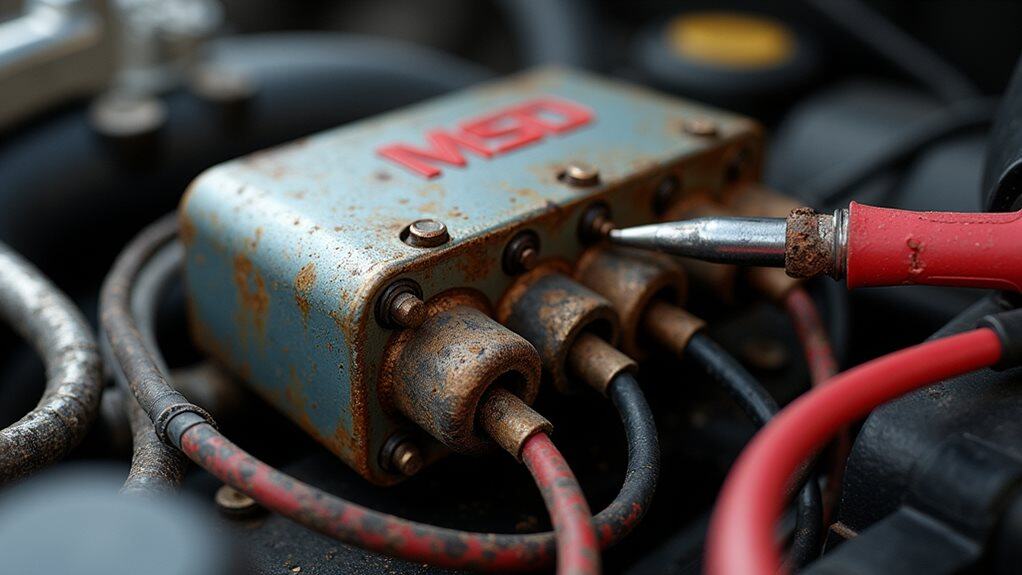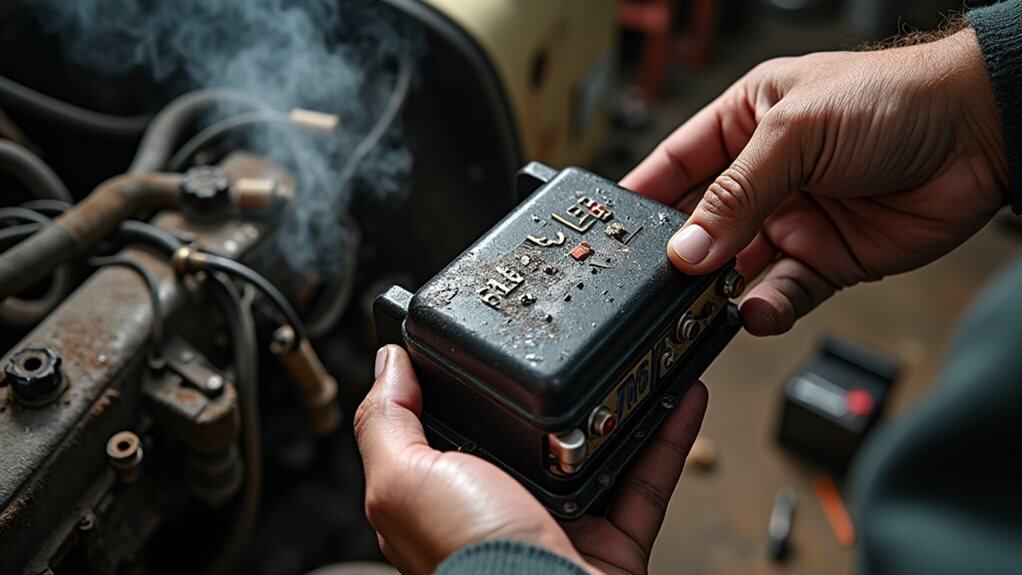You’ll notice a bad MSD ignition box when your engine loses reliable spark, the LED fails to light or flashes irregularly, or the car cranks but won’t fire under load. You may get weak or intermittent sparks, misfires at higher RPMs, timing instability, or sudden power loss, often caused by low supply voltage, poor grounding, or a bad magnetic pickup. Check battery/relay feeds, grounds, and trigger continuity to isolate the box; more troubleshooting steps follow.
Quick Tips
- No or weak spark at the plugs despite a good battery and coil connections, often causing no-starts.
- LED on the MSD either completely dark at key-on or flashing irregularly, indicating power, ground, or trigger faults.
- Engine cranks but fails to fire or spark disappears under starter load due to voltage drop or internal failure.
- Intermittent misfires, hesitation, or loss of spark at higher RPMs, often worsening with acceleration.
- Voltage sag, poor ground, or erratic/missing magnetic pickup signal measured at the MSD during faults.
No Spark or Weak Spark Output

Start by checking the basics, because most no-spark or weak-spark problems come from simple issues you can diagnose without special tools.
You should verify 12V on both main and small red feeds, inspect grounds and wiring for breaks or corrosion, test coil by swapping, and confirm magnetic pickup signal; shorting pickup wires or jumping distributor terminals helps isolate the MSD box from distributor faults. One common real-world cause is a poor ground or voltage drop on the power lead, so check the big red feed and relay connections for voltage drop. Proper grounding of the engine and battery negative to the block or chassis is often overlooked and can cause intermittent failures if corroded or loose engine ground.
LED Indicator Shows Abnormal or No Flashing
If the MSD’s LED doesn’t light with the key on, you’ve likely got no power or a bad ground at the box, so start by checking battery voltage at the MSD terminals and cleaning connections.
Irregular flash patterns—like rapid continuous blinking or odd long/short sequences when they shouldn’t occur—can mean a faulty trigger signal from the distributor/crank sensor, damaged wiring, or internal circuitry problems.
Use a voltmeter and simple jumper tests to confirm power, ground, and trigger continuity before concluding the box itself is bad. A common cause is improper battery and ignition-switched connections, so verify the two large cables are tied directly to the battery and the small red is on switched 12V.
A failing alternator can also cause voltage irregularities that affect MSD operation, so check charging system voltage output as part of your diagnosis.
No LED Illumination
When the MSD box shows no LED illumination at key-on or during cranking, you’re looking at a clear sign that power, trigger input, or the module itself isn’t functioning correctly, and you should methodically work through power and signal checks before assuming internal failure.
Check 12 V at power terminals, ground continuity, ignition-switch output, pickup trigger wiring, and coil connections to isolate the fault.
Irregular Flash Patterns
Having no LED at key-on pointed you toward power or a dead module, but odd or repeated flash patterns give a different set of diagnostic clues you can use to pinpoint wiring, trigger, or internal faults.
Rapid or one-per-second blinking usually means low or unstable voltage; no flash during cranking indicates missing trigger or power; inspect battery, heavy gauge grounds, trigger wiring, then bench-test the box.
Engine Cranks But Fails to Fire Under Load

When your engine cranks but won’t fire under load, first check for no spark at the plugs while cranking, because a complete absence of spark usually points to a failed MSD output, poor connections, or loss of pickup signal.
If you see a weak or intermittent spark—faint arcs or sparks that come and go—that suggests either a marginal coil/box connection, internal MSD component degradation, or voltage sag that only appears under load.
Measure the battery and key-on voltage at the MSD during cranking, since a voltage drop below roughly 10–11 volts can prevent proper spark generation even if the box seems okay at rest.
A failing starter or related electrical issues can also cause similar symptoms, so inspect the starter, solenoid, and battery for wear, corrosion, or voltage drop during cranking.
No Spark While Cranking
Because the engine cranks but won’t fire under load, you need to systematically check the MSD ignition system for power, trigger, coil, and grounding issues that commonly stop spark during cranking.
Verify heavy red wire to battery, solid ground to engine, and no voltage drop below ~10–11V.
Inspect magnetic pickup continuity, distributor rotor movement, coil resistance, connections, and MSD box wiring or internal faults.
Weak/Intermittent Spark
Occasionally you’ll see the engine crank normally but fail to fire under load, and that symptom often points to a weak or intermittent spark coming from the MSD ignition box; this problem shows up as sputtering, poor running at higher RPM, or no start when the engine is put under compression.
Check 12V supply, grounds, trigger pickup and wiring; test spark by jumpering distributor posts and measuring voltages.
Voltage Drop During Crank
If your engine cranks normally but won’t fire under load, a voltage drop at the MSD hot lead during cranking is one of the first things you should check, because MSD boxes need a steady 12–14 volts to generate a strong spark and anything below about 9–10 volts can prevent ignition.
Measure hot-lead volts before and while cranking, inspect wiring, grounds, battery health, and bypass suspect wiring looms to isolate the fault.
Intermittent Misfires or Hesitation at Higher RPMs

You’ll often notice intermittent misfires or hesitation at higher RPMs when an MSD ignition box can’t keep up with the faster trigger signals, and this symptom usually shows as surging, hesitation, or occasional backfires during hard acceleration.
You’ll see blinking LEDs during faults, uneven exhaust temperatures across cylinders, reduced spark intensity or erratic timing, and inconsistent dwell or missing pulses under load.
An exhaust leak before the oxygen sensor can also cause a lean condition that mimics or worsens misfire symptoms.
Voltage Supply Drops or Poor Grounding Symptoms
When the MSD ignition box doesn’t get a steady 12 volts or the chassis ground is poor, the unit can behave unpredictably and the engine will often show clear, measurable symptoms; voltage that falls below about 10–10.5 volts during cranking or under load commonly causes weak or missing spark, hard starting, stumbling under acceleration, and intermittent misfires.
Check battery, cables, ignition switch, clean grounds, and measure voltage at the MSD input; bypass wiring with a jumper to confirm supply or ground faults.
Distributor or Magnetic Pickup Signal Failures

Beyond checking voltage and grounds, the next area to inspect is the distributor’s magnetic pickup and its signal path, because even with a solid 12‑volt supply the MSD box can’t fire properly without a clean, consistent pickup pulse.
You’ll look for intermittent or no spark, corrosion on pickup or connectors, erratic timing, and spark dropouts; test continuity, jumper leads, clean contacts, and replace damaged pickups or wiring.
Wrapping Up
You can diagnose a failing MSD ignition box by observing specific signs: no or weak spark, abnormal LED behavior, the engine cranking without firing under load, misfires at higher RPMs, voltage drops or poor grounds, and distributor or magnetic pickup signal failures. Check wiring, grounds, supply voltage, and pickup resistance with a multimeter, and verify LED patterns against the manual. Replace the box if diagnostics and repairs don’t restore consistent, strong spark.

